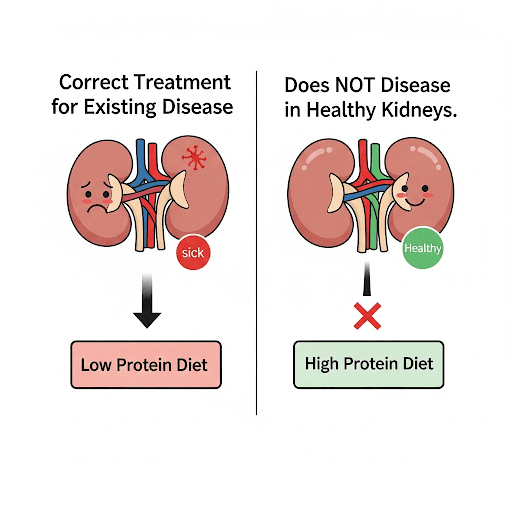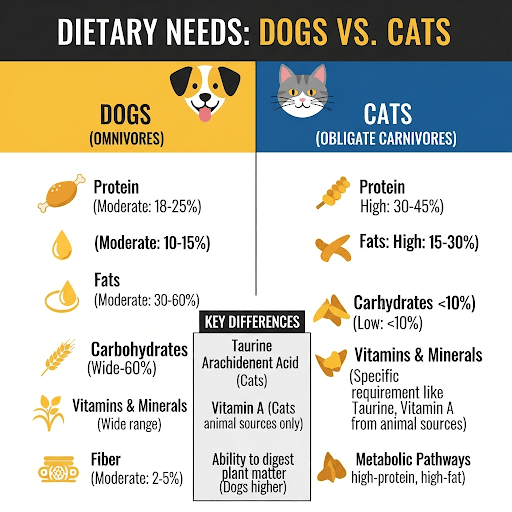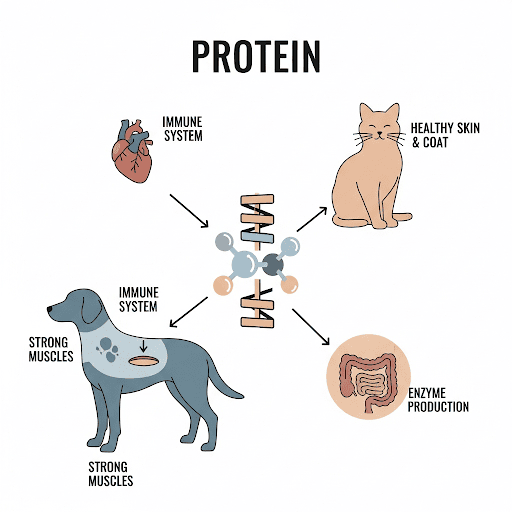Protein is the undisputed king of nutrients in our pets’ bowls. As the fundamental building block for muscle, skin, hair, and a healthy immune system, it’s essential for our carnivorous and omnivorous companions. Yet, despite its importance, no nutrient is surrounded by more persistent myths and unsubstantiated fears.
A pervasive belief circulates online and in pet stores that a high-protein diet is dangerous and will damage a healthy pet's kidneys. This fear causes many well-meaning owners to shy away from biologically appropriate diets, leaving them confused and worried.
It's time to tackle the question head-on: Can a pet have too much protein? Let's separate fact from fiction and explore what the science says about protein, healthy pets, and those with specific medical needs.
What Happens to "Excess" Protein in a Healthy Pet?
To understand the issue, we first need to know what a healthy pet's body does with the protein it consumes. When your dog or cat eats a protein-rich meal, their body gets to work.
- Building and Repairing: The first priority is to break the protein down into amino acids and use them for all their essential jobs—building and repairing muscle and tissue, creating hormones and enzymes, and supporting the immune system.
- Repurposing the Rest: If your pet consumes more protein than is needed for these immediate construction projects, the leftovers are not wasted. The body is far too efficient for that. The excess amino acids are taken to the liver where they are broken apart.
The nitrogen component is converted to urea, which is then sent to the kidneys to be easily filtered out and excreted in the urine.
The remaining carbon structure is converted by the body into a source of energy (calories) to be used immediately or stored as fat for later.
In a healthy pet, excess dietary protein is simply repurposed as fuel. It is not toxic, and the body is perfectly designed to handle it.
The Kidney Myth: Where Did This Idea Come From?
So, if the body handles excess protein so well, where did the myth that it harms kidneys come from? This is a classic case of a correct medical treatment being misunderstood and misapplied to a healthy population.
Here’s the truth about protein and kidney disease in pets: For a pet that has already been diagnosed with chronic kidney disease (CKD), veterinarians prescribe a therapeutic diet. These diets feature carefully controlled levels of exceptionally high-quality protein. The goal is to provide enough amino acids for bodily functions while reducing the amount of nitrogen waste the compromised kidneys have to filter, which makes the pet feel better.
The misunderstanding arose when people incorrectly flipped this logic. They assumed that if lower protein is part of the treatment for sick kidneys, then high protein must be the cause of sick kidneys. This is scientifically untrue. There is no evidence to suggest that a high protein diet for dogs or cats with healthy, functioning kidneys will cause damage. A healthy kidney's job is to filter waste, and it is fully equipped to handle the byproducts of protein metabolism.
Choosing the right protein level depends on your pet's individual health profile. Our meal planner helps you filter recipes based on life stage and needs. For a healthy, active adult dog, a higher protein diet can be ideal. For a senior pet with health concerns, a different profile might be needed. Our app helps you find vet-recommended options, but the decision should always be made in consultation with your veterinarian.
So, When IS High Protein a Concern?
While high protein diets are safe for most pets, there are specific medical situations where protein levels need to be managed carefully by a veterinarian.
- Diagnosed Chronic Kidney Disease (CKD): This is the number one reason to feed a protein-restricted diet. The goal is to reduce the workload on the failing kidneys.
- Certain Liver Conditions: Since the liver is involved in processing protein waste, some forms of advanced liver disease may also require a modified protein intake.
The Quality Factor: The quality and digestibility of the protein are arguably more important than the percentage. A diet with a moderate amount of highly digestible protein from a named animal source (like chicken or salmon) puts less strain on the body than a diet high in poor-quality, less digestible protein sources that create more waste.
As for cats, is too much protein bad for cats? As obligate carnivores, their bodies are even more adapted to metabolizing high-protein diets than dogs. The same principles apply: it is not a concern for healthy cats but must be carefully managed in felines diagnosed with kidney disease.
(Managing kidney disease requires very specific nutrition. Learn more in our guide [Nutrition for Pets with Kidney Disease: The Importance of Low Phosphorus].)

Conclusion: Focus on Quality, Not Fear
The belief that high-protein diets are dangerous for healthy pets is one of the most persistent and damaging myths in veterinary nutrition. For a healthy dog or cat, the body is a master of efficiency, using protein for its vital building roles and converting any surplus into life-sustaining energy.
Instead of being afraid of the protein percentage on the bag, focus on the quality of the ingredients. Choose diets that prioritize highly digestible, named animal proteins as their foundation.
Let go of the protein fear and embrace the facts. The right diet for your pet depends on their unique age, health status, and activity level. Always consult with your veterinarian to choose a nutritional plan that’s perfect for them, and use our meal planner to confidently find high-quality options that fit their individual profile.


